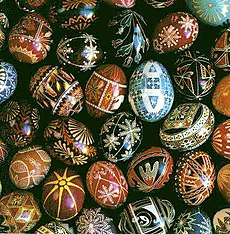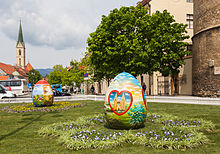
Easter eggs, also called Paschal eggs, are eggs that are decorated for the Christian feast of Easter, which celebrates the resurrection of Jesus. As such, Easter eggs are common during the season of Eastertide. The oldest tradition, which continues to be used in Central and Eastern Europe, is to use dye and paint chicken eggs.
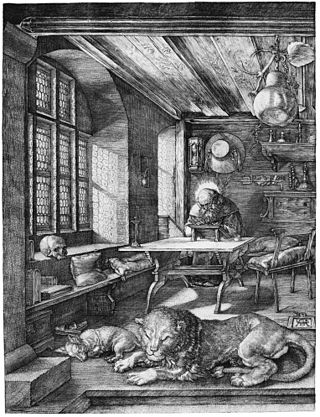
Engraving is the practice of incising a design onto a hard, usually flat surface by cutting grooves into it with a burin. The result may be a decorated object in itself, as when silver, gold, steel, or glass are engraved, or may provide an intaglio printing plate, of copper or another metal, for printing images on paper as prints or illustrations; these images are also called "engravings". Engraving is one of the oldest and most important techniques in printmaking.

Slavic mythology or Slavic paganism is the religious beliefs, myths, and ritual practices of the Slavs before Christianisation, which occurred at various stages between the 8th and the 13th century. The South Slavs, who likely settled in the Balkan Peninsula during the 6th–7th centuries AD, bordering with the Byzantine Empire to the south, came under the sphere of influence of Eastern Christianity, beginning with the creation of writing systems for Slavic languages in 855 by the brothers Saints Cyril and Methodius and the adoption of Christianity in Bulgaria in 864 and 863 in Great Moravia. The East Slavs followed with the official adoption in 988 by Vladimir the Great of Kievan Rus'.

Genyornis newtoni, also known as the Newton's mihirung, Newton's thunder bird or mihirung paringmal, is an extinct species of large, flightless bird that lived in Australia during the Pleistocene Epoch until around 50,000 years ago. Over two metres in height, they were likely herbivorous. Many other species of Australian megafauna became extinct in Australia around that time, coinciding with the arrival of humans. It is the last known member of the extinct flightless bird family Dromornithidae which had been part of the fauna of the Australian continent for over 30 million years. They are not closely related to ratites such as emus, and their closest living relatives are thought to be fowl.

An egg is an organic vessel grown by an animal to carry a possibly fertilized egg cell and to incubate from it an embryo within the egg until the embryo has become an animal fetus that can survive on its own, at which point the animal hatches.

In art history, the French term objet d’art describes an ornamental work of art, and the term objets d’art describes a range of works of art, usually small and three-dimensional, made of high-quality materials, and a finely-rendered finish that emphasises the aesthetics of the artefact. Artists create and produce objets d’art in the fields of the decorative arts and metalwork, porcelain and vitreous enamel; figurines, plaquettes, and engraved gems; ivory carvings and semi-precious hardstone carvings; tapestries, antiques, and antiquities; and books with fine bookbinding.

Egg rolling, or an Easter egg roll is a traditional game played with eggs at Easter. Different nations have different versions of the game, usually played with hard-boiled, decorated eggs.

A cascarón is a hollowed-out chicken egg filled with confetti or small toys. Cascarones are common throughout Mexico and are similar to the Easter eggs popular in many other countries. They are mostly used in Mexico during Carnival, but in American and Mexican border towns, the cultures combined to make them a popular Easter tradition.

Stucco decoration in Islamic architecture refers to carved or molded stucco and plaster. The terms "stucco" and "plaster" are used almost interchangeably in this context to denote most types of stucco or plaster decoration with slightly varying compositions. This decoration was mainly used to cover walls and surfaces and the main motifs were those predominant in Islamic art: geometric, arabesque, and calligraphic, as well as three-dimensional muqarnas. Plaster of gypsum composition was extremely important in Islamic architectural decoration as the relatively dry climate throughout much of the Islamic world made it easy to use this cheap and versatile material in a variety of spaces.
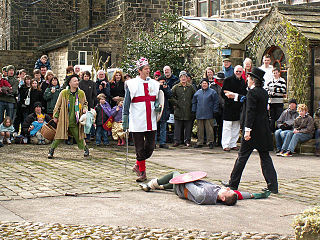
The Pace Egg plays are an Easter custom in rural Northern England in the tradition of the medieval mystery plays. The practice was once common throughout Northern England, but largely died out in the nineteenth century before being revived in some areas of Lancashire and West Yorkshire in the twentieth century. The plays, which involved mock combat, were performed by Pace Eggers, who sometimes received gifts of decorated eggs from villagers. Several closely related folk songs were associated with Pace Egging.

The tradition of egg decoration in Slavic cultures originated in pagan times, and was transformed by the process of religious syncretism into the Christian Easter egg. Over time, many new techniques were added. Some versions of these decorated eggs have retained their pagan symbolism, while others have added Christian symbols and motifs.

Cookie decorating dates back to at least the 14th century when in Switzerland, springerle cookie molds were carved from wood and used to impress Biblical designs into cookies.

Easter traditions are customs and practices that are followed in various cultures and communities around the world to celebrate Easter, which is the central feast in Christianity, commemorating the resurrection of Jesus. The Easter season is seen as a time of celebration and feasting, in contrast to the antecedent season of Lent, which is a time of penitence and fasting.
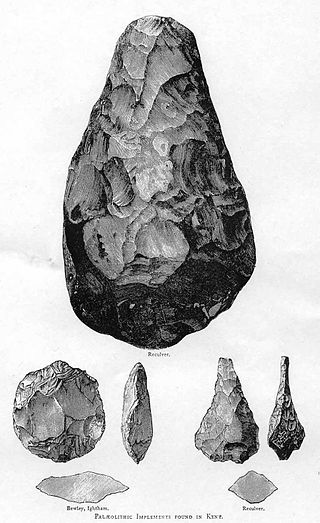
The oldest undisputed examples of figurative art are known from Europe and from Sulawesi, Indonesia, dated about 35,000 years old . Together with religion and other cultural universals of contemporary human societies, the emergence of figurative art is a necessary attribute of full behavioral modernity.

The visual art of Botswana has varied among the different ethnic groups and throughout history. Historically it has fallen into two main categories: that of the San peoples and that of the Bantu-derived peoples such as the Batswana...

Egg shoeing is an egg decorating technique. According to Hungarian oral traditions, egg shoeing was invented by village blacksmiths to prove their skills by creating an egg which was shod by miniature horseshoes. This technique is currently in decline due to the decreasing number of blacksmiths; it is mainly practiced in arts and crafts workshops, fairs and in the Szentendre open-air museum.

A German tradition of decorating trees and bushes with Easter eggs is known as the Ostereierbaum, or Easter egg tree. A notable example is the Saalfelder Ostereierbaum in Saalfeld, Thuringia.

The Pyxis of Zamora is an carved ivory casket (pyx) that dates from the Caliphate of Córdoba. It is now in the National Archaeological Museum of Spain in Madrid, Spain.

Kalti paarti carving is an art form made by carving a kalthi-parti, or emu egg. The practice began in the mid to late nineteenth century and while it has been practiced by people in Australia from many backgrounds, it is often strongly associated with Aboriginal art.

The egg of the ostrich is the largest of any living bird. The shell has a long history of use by humans as a container and for decorative artwork, including beads. The eggs are not commonly eaten.
